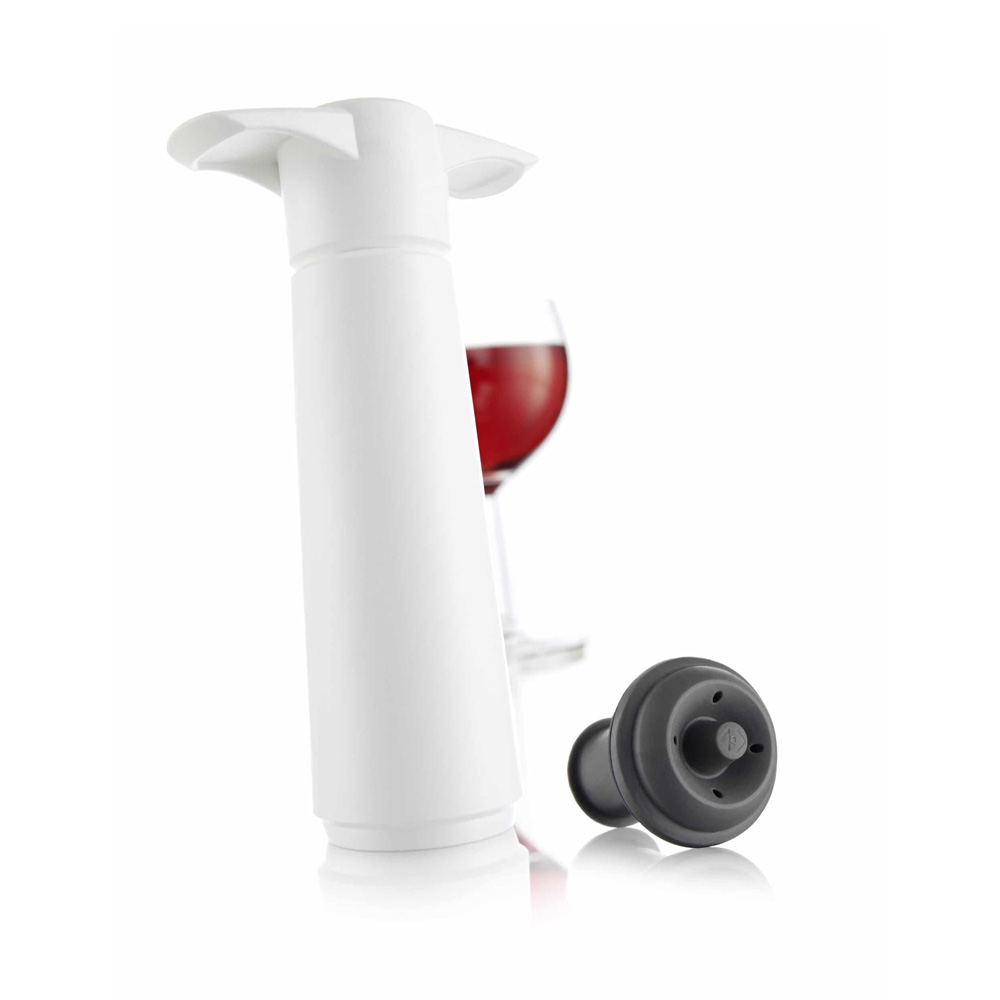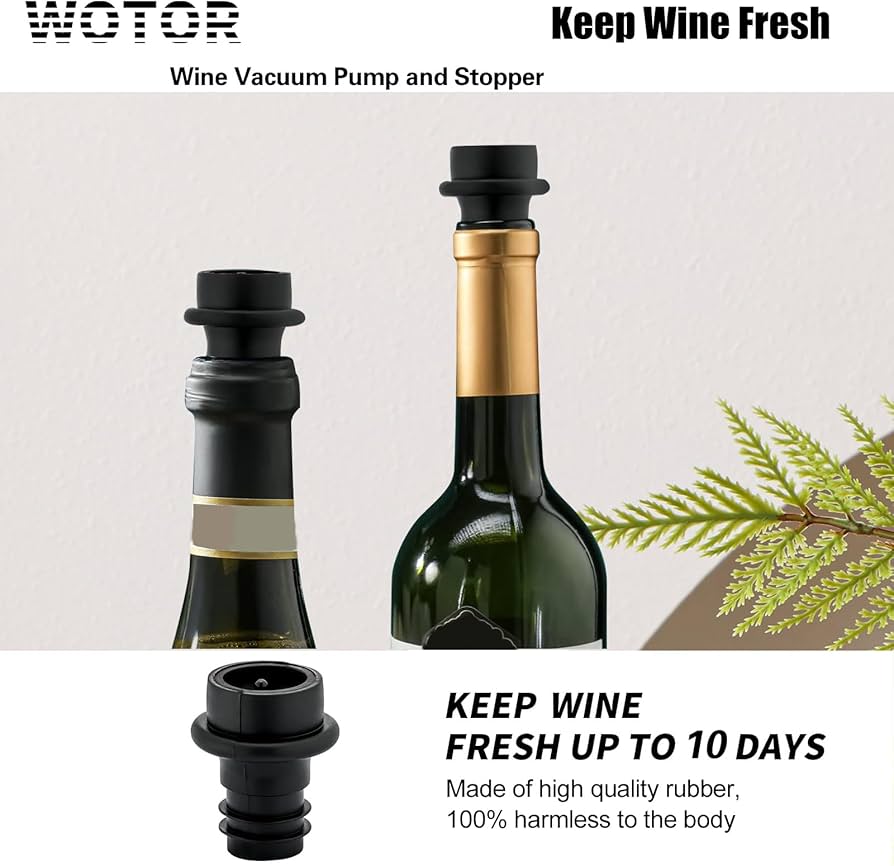Bottle wine stopper vacuum pump guide
Wine preservation systems use either a hand pump or electric vacuum pump to extract air from the bottle, then seal it with a special stopper featuring a one-way valve. By minimizing oxygen exposure, this vacuum seal dramatically slows down the chemical reactions that dull flavors, weaken aromas, and eventually turn opened wine sour.
Do vacuum wine stoppers work
Lab tests confirm that vacuum-sealed bottles retain 70-80% of their original aroma after five days, while unprotected wine starts declining within 24-48 hours. The best wine bottle preserver models create an airtight seal on standard 750ml bottles (28-30mm neck) without needing adapters – they work equally well with both cork and screw-top bottles.
Manual wine vacuum pumps require several pumps until you feel resistance indicating a proper vacuum, while electric models deliver consistent suction with just a button press. Both types effectively reduce oxidation by removing air, though neither can eliminate oxygen already dissolved in the wine or stop all chemical changes completely.
Vacuum wine savers work excellently for still wines – reds, whites and rosés – which benefit from reduced oxygen exposure. For champagne and other sparkling wines, special pressure-retaining stoppers are needed instead, as using a vacuum pump would release the precious bubbles along with the air.
How long vacuumed bottles last
Both user experiences and manufacturer data show that vacuum-sealed bottles remain enjoyable for 5-10 days when stored correctly – significantly longer than the 1-3 days you’d get from an unprotected opened bottle. Electric wine vacuum pump models often achieve a stronger vacuum with less effort, making them ideal for frequent wine drinkers.
Storage conditions make a big difference: keep whites and rosés chilled between 10-15°C, and store reds at about 12-14°C in a wine fridge to slow deterioration. Always store vacuum-sealed bottles upright in a cool, dark place to maintain the seal – laying them down can cause the stopper to loosen, allowing air to creep back in.
Choosing the best wine preserver
Look for stoppers made from high-quality, food-grade silicone or rubber that won’t absorb odors, provides an airtight seal, and cleans easily (many are dishwasher safe). Sets with multiple stoppers let you preserve several opened bottles of wine at once – perfect for entertaining or enjoying different wines by the glass.
Consider models with handy features like date markers or color indicators that help track how long each bottle has been preserved. Learn how a wine vacuum preserver can keep your wine fresh for weeks, especially if you’re looking for a preservation method that complements or enhances traditional techniques.
Bottle wine stopper tips for a red wine saver
A good wine stopper and vacuum pump can make all the difference in preserving red wine. By removing excess air, you slow down oxidation that affects the wine’s color, tannins, and overall taste. To maximize freshness, store your bottle of wine upright in a cool place (12–14°C) – with the right wine preserver, your red can stay drinkable for up to a week.
Keep wine fresh after opening
Speed matters when preserving open wine. Insert your vacuum stopper immediately after pouring to minimize oxygen exposure. Pump until you feel resistance or hear the valve click – this confirms a proper vacuum seal has formed. The less air left in the bottle, the better your wine preservation results will be.
- Seal fast: The quicker you cap your bottle after opening, the more you’ll protect the wine’s character.
- Store upright: Keeping bottles vertical helps maintain the vacuum and keeps the valve from getting wet.
- Control temperature: Cooler storage (12-14°C for reds) significantly slows chemical changes.
- Clean stoppers: Wash rubber or silicone stoppers with mild soap, or use dishwasher-safe models when available.
Always check the wine’s appearance, smell and taste before drinking. If you notice browning or sour notes, your wine pump can no longer maintain quality. For longer-term storage (over two weeks), consider pairing your vacuum preserver with argon gas – some specialized systems can extend freshness for a full month.
Manual vs electric vacuum pump
Manual wine pumps offer affordability and portability, typically requiring about 8 pumps per bottle. Great for occasional drinkers, some models include 2 stoppers – perfect if you regularly have more than one open wine bottle at a time.
Electric versions create a more consistent vacuum seal with just a button press, making them ideal if you frequently have multiple bottles open. Many automatically stop when optimum pressure is reached, taking the guesswork out of wine preservation.
When searching for the best wine preserver UK options, compare vacuum strength, valve quality, and included accessories. Learn how vacuum stoppers and argon systems work together to keep wine fresh for weeks, helping you choose the right solution for your needs.
Bottle champagne bottle stopper and wine preservation systems
While vacuum wine preservers work for still wines, they’re not ideal for bubbly varieties—the air extraction process removes dissolved CO₂, causing champagne, prosecco and cava to lose their signature fizz. Instead, use a pressure-retaining bottle stopper that creates an airtight seal, preserving carbonation and keeping your sparkling wine lively for up to a week.
Best champagne stopper for bubbles
Top-performing champagne stoppers feature either a clamp or wing-arm mechanism that securely fastens to the bottle neck. They also include a thick silicone or rubber gasket that forms a tight seal. Designed to withstand 5-6 atmospheres of pressure, this setup prevents gas from escaping through the valve while maintaining both flavor and texture.
- Secure clamping: Metal wings or hinged clips grip the bottle rim firmly, distributing pressure evenly to prevent leaks during storage.
- Flexible seal: A 3-5mm silicone gasket adapts to minor bottle imperfections, ensuring carbonation stays intact even in colder fridge conditions.
- Pressure handling: High-quality stoppers maintain up to 6 bar of pressure, keeping your opened wine fresh and bubbly for 5-7 days.
- Universal fit: Most models work with standard champagne bottles and many prosecco shapes without needing special adapters.
For best results, store the sealed bottle upright in a refrigerator set between 4-8°C—the cooler temperature slows gas diffusion, preserving both taste and bubbles. Check the seal daily by gently pressing the stopper; if it feels firm, the pressure is stable and your leftover wine will still have plenty of sparkle when you pour it.
Inert gas wine preservation
These advanced wine preservation systems use a food-grade mixture of argon and CO₂ gas to displace oxygen in the bottle’s headspace, effectively preventing oxidation. This method keeps still wines fresh for an impressive 30 days—far longer than standard vacuum wine preservers or simple vacuum stoppers.
Since argon is heavier than air, it forms a protective blanket over the wine’s surface without altering its flavor, aroma or color. Each gas cartridge typically preserves about eighteen servings (three standard 750ml bottles). The included dispensing gun provides controlled gas release while pouring, filling the headspace and delivering wine through a drip-free stainless steel spout.
| Preservation method | Duration | Best for | Maintenance |
| Vacuum pump | 5-10 days | Everyday still wines | Rinse stoppers after use |
| Inert gas | Up to 30 days | Premium reds, whites, rosés | Replace cartridges, clean spout |
| Pressure stopper | 5-7 days | Sparkling wines | Check gasket seal regularly |
| Refrigeration only | 1-3 days | Quick consumption | None required |
How to keep wine fresh
Immediately seal your bottle after pouring each glass using a vacuum seal, inert gas preserver, or pressure stopper—this minimizes oxygen exposure. Store open wine upright in a cool, dark place: standard refrigerators for whites and rosés, or wine coolers set to 12-14°C for reds. Proper storage slows chemical reactions that degrade taste and helps avoid unnecessary waste of good wine.
Regular cleaning is essential for all wine preservation systems: wash vacuum pumps and vacuum stoppers with warm soapy water, clean inert gas spouts with a brush, and inspect pressure-stopper gaskets for any damage. Discover our premium wine vacuum preserver set that combines easy pouring with effective preservation—helping prevent oxidation, reduce waste, and keep your remaining wine perfectly fresh for days or weeks after opening.


